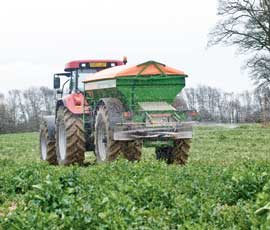OSR benefits from growth regulation

In stark contrast to the past two seasons, most winter oilseed rape crops will benefit from growth regulation this spring, believe agronomists.
As well as crops being more advanced than in previous years, there has been a swing to taller varieties, which require some height manipulation for best results, they point out.
But the recommended timing of the treatment varies, depending on the need for disease and weed control, as well as progress with other field operations.
“Plants have survived the cold winter almost unscathed,” says Nick Myers of ProCam. “The aim now is to create the optimum sized canopy, while eliminating any disease threats.”
Last year’s dry spring prevented crops from becoming too tall or advanced, he adds. “A more conducive growing season this year will mean growers need to take remedial action.”
Where fresh phoma infections still need treating, or light leaf spot is active, there is a strong case for a stem extension fungicide, he says. “That could be based on flusilazole if there’s no need for growth regulation, or either metconazole or tebuconazole, if a check is required.”
An economic response to PGRs (plant growth regulators) can be expected if crops already had a Green Area Index of 1.0 towards the end of February, he adds.
“If they’re not at that stage, then don’t use a growth regulating fungicide. Backwards crops are more likely to benefit from an immediate application of phosphite and other micronutrients, than a fungicide.”
Richard Elsdon of United Oilseeds is also advocating PGRs for most crops, although he favours a slightly later timing than stem extension to coincide with the start of sclerotinia control.
“If you apply it at the latish green bud stage, you’ll be doing two jobs from one application. Most of the phoma spraying in this area was completed a fortnight ago, so that opportunity has gone.”
He also uses Green Area Index as a guide, with crops at 1.0 or above being selected for treatment, but adds that plant population has an effect too.
“If you’ve only got 25 plants/sq m of a conventional variety, then you need to think hard about giving it a check. But 35 plants/sq m of a hybrid variety is a definite case for a PGR.”
Keeping crops short and managed makes it much easier to get the desired canopy structure, he ends.
In Lincolnshire, independent agronomist Bridget Carroll is also planning widespread use of growth-regulating fungicides.
But she places more importance on field history and previous crop performance than canopy size, picking out the subsoiled crops as being the most advanced.
Full-rate metconazole (Caramba) is her preferred choice, with applications going on as soon as conditions allow. “We’ll be combining it with the need for broad-leaved weed control, especially mayweeds which are already a good size. So the timing is early.”
Phoma is also showing, she notes, with varietal differences apparent. “Fortunately, metconazole will take care of it.”
She advises a field-by-field assessment of the need for growth regulation. “Any backwards crops need a different approach and they will benefit from some additional nitrogen.”
Canopy care
A new iPhone app has been launched to help growers make instant calculations of green area index (GAI) for oilseed rape crops.
The BASF Mobile GAI Tool launched by BASF, in association with Farmers Weekly, is available to download from the Apple iStore, costing £1.79.
The app has been designed to provide the same functionality as the current BASF GAI tool. Go to www.fwi.co.uk/gai-app and see a video demonstration on what it does and how to use it.

